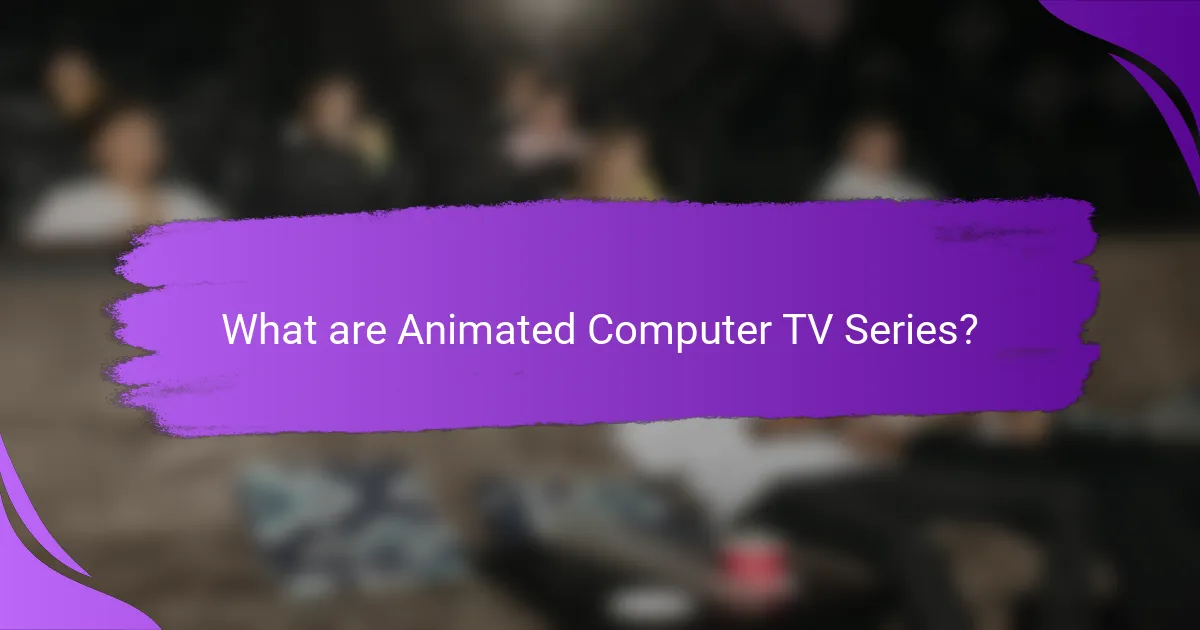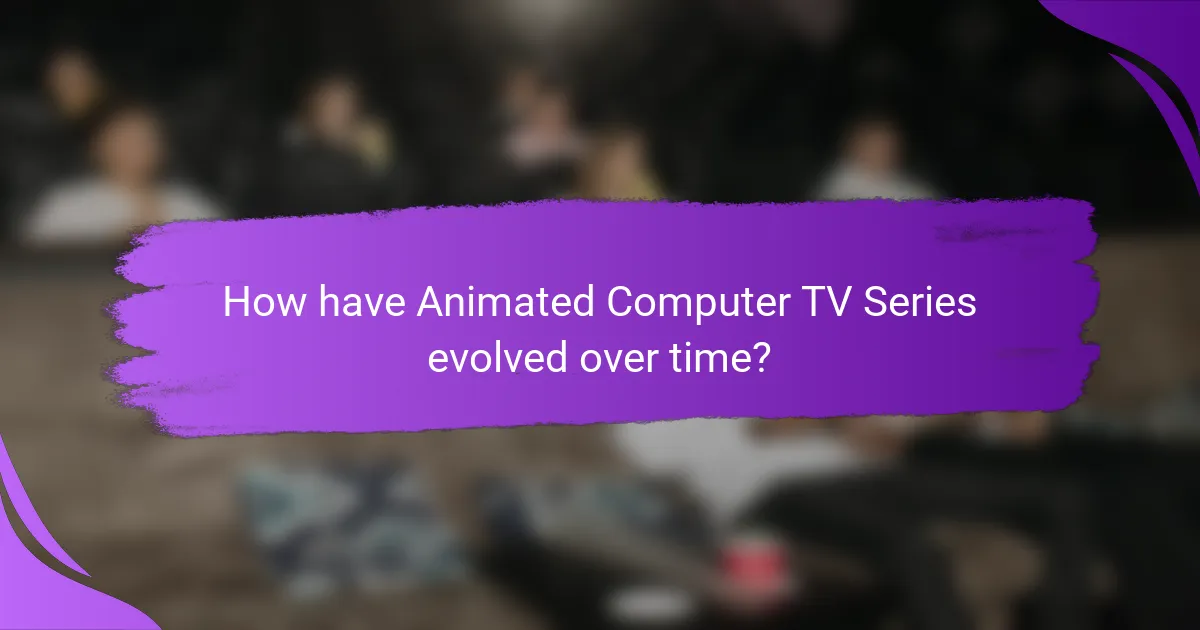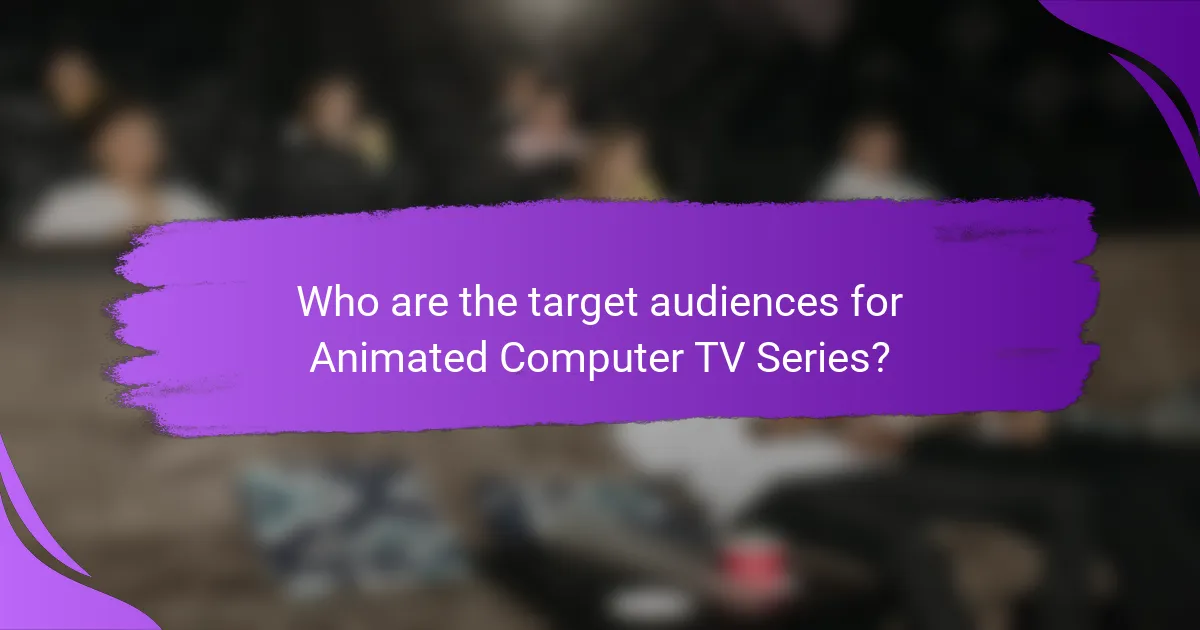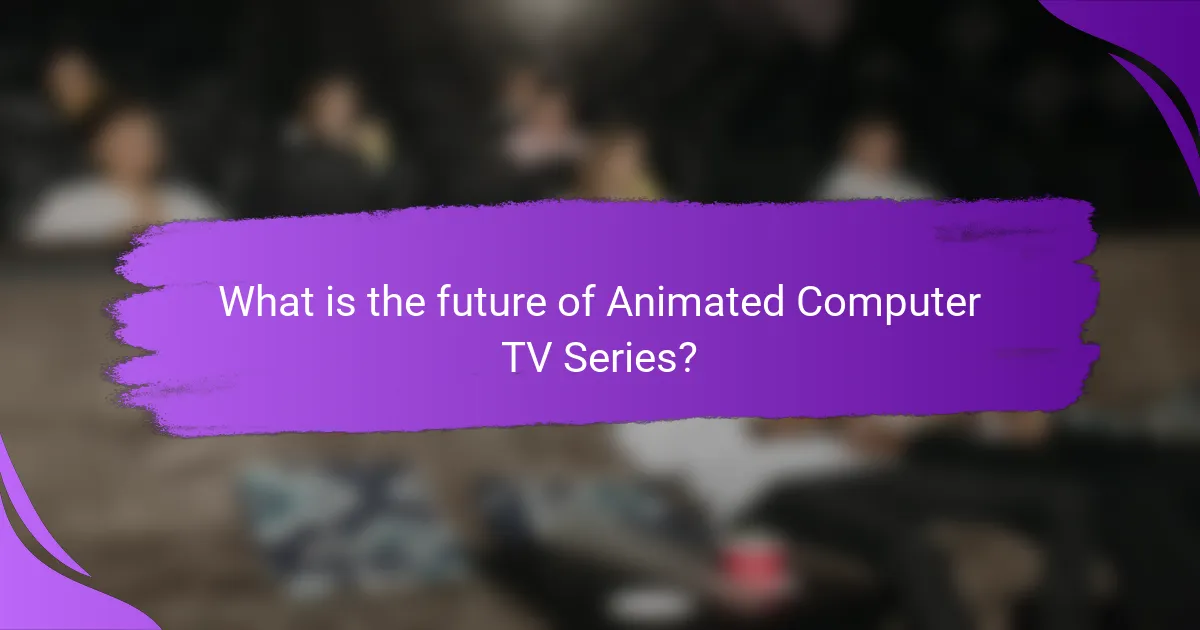Animated computer TV series are television programs created using computer-generated imagery (CGI), known for their vibrant graphics and dynamic character movements. This article explores the evolution of these series, highlighting their progression from simplistic graphics to sophisticated storytelling that appeals to diverse age groups, including children, teenagers, and adults. It discusses the cultural significance of animated series, their reflection of contemporary issues, and the impact of streaming platforms on narrative diversity. Additionally, the article examines the future trends in animated content, including advancements in technology that promise increased interactivity and viewer engagement.

What are Animated Computer TV Series?
Animated computer TV series are television programs created using computer-generated imagery (CGI). These series utilize digital animation techniques to produce visual content. They often feature vibrant graphics and dynamic character movements. Popular examples include shows like “Toy Story That Time Forgot” and “The Dragon Prince.” Animated computer TV series appeal to various age groups, from children to adults. The use of CGI allows for creative storytelling and imaginative worlds. They have gained popularity due to advancements in technology and animation software. The global market for animated series has expanded significantly in recent years, reflecting their cultural significance.
How did Animated Computer TV Series originate?
Animated computer TV series originated in the late 20th century with advancements in computer graphics technology. The first notable series was “ReBoot,” which premiered in 1994. It utilized 3D animation techniques, showcasing the potential of computer-generated imagery in television. Following “ReBoot,” other series like “Beast Wars: Transformers” also emerged, further popularizing this format. The rise of personal computers and software like 3D Studio Max facilitated the creation of animated content. By the early 2000s, shows like “Code Lyoko” and “Avatar: The Last Airbender” integrated computer animation with traditional techniques. This evolution marked a significant shift in animation styles and storytelling in television.
What technological advancements contributed to their creation?
Advancements in computer graphics technology significantly contributed to the creation of animated computer TV series. High-performance rendering engines improved visual fidelity. Real-time animation software enabled quicker production cycles. Developments in 3D modeling allowed for more complex character designs. Motion capture technology enhanced realism in animation. Streaming technology facilitated wider distribution and accessibility. These advancements collectively transformed the landscape of animated television.
What were the early examples of Animated Computer TV Series?
Early examples of animated computer TV series include “ReBoot,” which premiered in 1994. This series was notable for being one of the first fully computer-generated animated shows. Another example is “Beast Wars: Transformers,” which debuted in 1996 and utilized CGI technology. “Transformers” was significant for its storytelling and character development. “Mainframe Entertainment” produced both series, showcasing the potential of computer animation in television. These shows marked a pivotal shift in animation styles and techniques during the 1990s.
What are the defining characteristics of Animated Computer TV Series?
Animated computer TV series are defined by their use of computer-generated imagery (CGI) for animation. This technology allows for high-quality visuals and detailed character designs. The series often feature vibrant colors and dynamic movements, enhancing visual storytelling. They typically target a wide range of audiences, from children to adults. Many series incorporate humor, adventure, and relatable themes to engage viewers. Furthermore, they often explore contemporary social issues, reflecting cultural significance. Shows like “Toy Story” and “The Incredibles” exemplify these characteristics through their innovative animation and storytelling.
How do art styles vary in Animated Computer TV Series?
Art styles in animated computer TV series vary significantly based on artistic intent, audience, and cultural context. Different series utilize distinct animation techniques, such as 2D, 3D, and stop-motion. For instance, shows like “The Simpsons” employ a flat, cartoonish style while “Toy Story” showcases advanced 3D animation.
Art styles also reflect the target demographic. Series aimed at children often feature bright colors and exaggerated characters, as seen in “Paw Patrol.” In contrast, shows for adults may adopt a more realistic or abstract approach, as demonstrated by “Bojack Horseman.”
Cultural influences shape these styles as well. For example, anime series like “Attack on Titan” incorporate unique character designs and visual storytelling techniques rooted in Japanese culture. This diversity in art styles enhances viewer engagement and reflects broader societal themes.
What role does animation technology play in their development?
Animation technology serves a crucial role in the development of animated computer TV series. It enables creators to produce visually engaging content efficiently. Advanced software allows for intricate designs and fluid movements. This technology facilitates the integration of 3D elements into traditionally 2D animations. As a result, series can appeal to a wider audience with diverse art styles. Animation technology also streamlines the production process, reducing time and costs. Innovations in rendering and simulation enhance the storytelling experience. Overall, animation technology significantly shapes the creative possibilities and marketability of animated series.

How have Animated Computer TV Series evolved over time?
Animated computer TV series have evolved significantly since their inception. Initially, they featured simplistic graphics and basic animation techniques. Early examples include “ReBoot,” which debuted in 1994, showcasing 3D animation in a unique digital world. As technology advanced, so did the complexity of animation. The introduction of higher resolution graphics allowed for more detailed and vibrant visuals.
By the early 2000s, series like “Avatar: The Last Airbender” demonstrated sophisticated storytelling and character development, appealing to a broader audience. The use of CGI became more prevalent, enhancing visual appeal and realism.
In recent years, streaming platforms have influenced the evolution of animated series. Shows like “Big Mouth” and “Castlevania” have pushed boundaries with mature themes and diverse storytelling. The target audience has expanded, attracting both children and adults.
Culturally, animated series now reflect contemporary issues and diverse perspectives, showcasing a significant shift from purely entertainment to social commentary. This evolution highlights the growing importance of animated computer TV series in popular culture.
What major milestones mark the evolution of Animated Computer TV Series?
The evolution of animated computer TV series is marked by several major milestones. The introduction of “ReBoot” in 1994 was significant as the first fully computer-generated animated series. In 1999, “Toy Story” set a new standard for animation with its feature-length CGI format. The launch of “The Simpsons” in 1989 showcased the potential of animation in prime-time television. The advent of streaming platforms like Netflix in the 2010s revolutionized distribution for animated series. The release of “Big Mouth” in 2017 highlighted the growth of [censured] animation. In 2020, “Wolfwalkers” demonstrated the integration of traditional and digital animation techniques. Each of these milestones contributed to the evolution of animated computer TV series, shaping their artistic styles and cultural significance.
How have audience preferences influenced their evolution?
Audience preferences have significantly influenced the evolution of animated computer TV series. As viewers’ tastes shifted, creators adapted content to meet these demands. For instance, the rise of [censured] animation in the late 1990s reflected a growing appetite for more mature themes. Shows like “The Simpsons” and “South Park” showcased this trend, attracting a wider demographic. Additionally, advancements in technology allowed for diverse art styles, appealing to various audience segments. The incorporation of social issues and cultural references further resonated with viewers, enhancing relatability. Data from Nielsen ratings indicate that series catering to specific audience preferences often experience higher viewership and longevity.
What impact has streaming technology had on their development?
Streaming technology has significantly transformed the development of animated computer TV series. It has enabled creators to reach global audiences instantly. This accessibility allows for diverse storytelling and experimentation with various art styles. Streaming platforms have also provided creators with more creative freedom compared to traditional networks. For instance, series can be produced without the constraints of time slots or commercial breaks. The success of shows like “Bojack Horseman” and “Big Mouth” illustrates this shift. These series explore mature themes and unconventional narratives that may not have thrived on cable television. Furthermore, streaming technology has increased viewer engagement through interactive features and binge-watching capabilities. This has led to a deeper connection between audiences and the content. Overall, streaming technology has reshaped the landscape of animated computer TV series, fostering innovation and diversity in the medium.
What are the different art styles used in Animated Computer TV Series?
Animated computer TV series utilize various art styles. Common styles include 2D animation, which features flat images and is often characterized by vibrant colors. 3D animation provides depth and realism, allowing for intricate character designs and environments. Stop-motion animation uses physical models and captures them frame by frame for a unique look. Cel-shaded animation mimics a hand-drawn aesthetic while using 3D models. Each style serves different storytelling purposes and appeals to diverse audiences. The choice of art style can significantly impact viewer engagement and emotional response.
How do different art styles affect viewer engagement?
Different art styles significantly impact viewer engagement. Each style evokes distinct emotional responses. For instance, vibrant colors and exaggerated forms often attract younger audiences. In contrast, minimalist designs may resonate more with adults seeking sophistication. Research indicates that viewers spend more time engaging with content that aligns with their aesthetic preferences. A study published in the Journal of Visual Culture found that animation styles like anime can enhance emotional connection, leading to increased viewer retention. Additionally, diverse art styles can broaden audience appeal, attracting viewers from various demographic backgrounds. Thus, the choice of art style plays a crucial role in shaping viewer experiences and engagement levels.
What are the most popular art styles in recent series?
The most popular art styles in recent animated series include 2D animation, 3D animation, and mixed media. 2D animation remains prevalent due to its nostalgic appeal and simplicity. Shows like “Adventure Time” and “The Owl House” exemplify this style. 3D animation has gained popularity for its depth and realism. Series like “Big Mouth” and “Love, Death & Robots” showcase this technique effectively. Mixed media combines various styles, enhancing visual storytelling. This is evident in “Spider-Man: Into the Spider-Verse,” which uses a blend of 2D and 3D elements. These styles reflect trends in technology and audience preferences.

Who are the target audiences for Animated Computer TV Series?
The target audiences for animated computer TV series include children, teenagers, and adults. Children are drawn to colorful characters and engaging storylines. Teenagers often appreciate humor and relatable themes. Adults may enjoy sophisticated narratives and nostalgia. Additionally, families watch together, making these series appealing across age groups. Market research indicates a growing interest in animated content among older viewers. This trend reflects broader cultural shifts towards accepting animation as a legitimate storytelling medium for all ages.
What demographics are most engaged with Animated Computer TV Series?
Young adults aged 18 to 34 are the most engaged demographic with animated computer TV series. This group often appreciates the humor and storytelling styles presented in these shows. Additionally, children aged 6 to 12 also show significant engagement. Their interest is driven by colorful animation and relatable characters. Research indicates that animated series attract diverse audiences, including families. For example, a study by Nielsen reported that 70% of animated series viewers are under 35 years old. This highlights the appeal of animation across different age groups, particularly among younger viewers.
How do series cater to different age groups?
Series cater to different age groups by tailoring content, themes, and presentation styles. For children, series often feature bright colors, simple narratives, and moral lessons. These elements engage young viewers and promote learning. Series aimed at teenagers include more complex plots and relatable characters. They address issues like identity, relationships, and social challenges. [censured]-targeted series often explore deeper themes, including satire and social commentary. This variety allows each age group to find relevant content. Research shows that age-appropriate themes enhance viewer engagement and retention. For example, studies indicate that children prefer characters they can relate to, while adults appreciate nuanced storytelling.
What themes resonate with specific audiences?
Themes that resonate with specific audiences include nostalgia, humor, and social issues. Nostalgia appeals to older viewers who grew up with certain styles or characters. Humor attracts younger audiences looking for entertainment and relatability. Social issues engage viewers interested in contemporary topics like diversity and mental health. Research shows that animated series addressing social themes can increase viewer engagement. For example, shows like “BoJack Horseman” tackle mental health, resonating with a broad audience. Similarly, “The Simpsons” uses humor to comment on societal norms, appealing to diverse demographics.
How do Animated Computer TV Series address cultural themes?
Animated computer TV series address cultural themes by incorporating diverse narratives and character representations. These series often reflect societal issues such as race, gender, and identity. For example, shows like “Avatar: The Last Airbender” explore themes of war and peace, drawing from various cultural traditions. They also use humor and satire to comment on contemporary issues, as seen in “The Simpsons.”
Additionally, animated series frequently include cultural references that resonate with specific audiences. This can foster a sense of belonging and representation among viewers. Research indicates that media representation can significantly impact cultural perceptions and social attitudes. Therefore, animated computer TV series play a crucial role in shaping cultural dialogue and understanding.
What cultural significance do these series hold in society?
Animated computer TV series hold significant cultural importance by reflecting societal values and trends. They often address contemporary issues such as diversity, mental health, and environmental concerns. These series provide a platform for marginalized voices and promote inclusivity. For example, shows like “Avatar: The Last Airbender” explore themes of friendship and responsibility. They also influence language and behavior, especially among younger audiences. Research indicates that animated series can enhance empathy and understanding in viewers. Additionally, they contribute to the global entertainment landscape, shaping cultural exchange and dialogue.
How do they reflect or challenge social norms?
Animated computer TV series reflect and challenge social norms through their storytelling and character representation. These series often depict diverse characters and scenarios that may not align with traditional societal expectations. For instance, shows like “The Simpsons” and “Bob’s Burgers” address family dynamics in non-traditional ways. They challenge the notion of the ideal family structure by showcasing flawed characters and unconventional relationships.
Additionally, animated series like “Steven Universe” promote inclusivity and acceptance of different identities. They reflect changing social attitudes towards gender and sexuality. Characters in these series often embody traits that defy stereotypical gender roles. This representation can influence audience perceptions and foster discussions about societal norms.
Furthermore, animated series frequently tackle contemporary issues such as mental health, race, and environmentalism. For example, “Big Mouth” explores puberty and [censured] education, confronting taboos in a humorous yet educational manner. This approach can challenge viewers to reconsider their beliefs and attitudes.
Overall, animated computer TV series serve as a mirror to society, reflecting its complexities while simultaneously pushing boundaries and encouraging dialogue about social norms.

What is the future of Animated Computer TV Series?
The future of animated computer TV series is expected to be characterized by increased interactivity and personalization. Advances in technology will allow for more immersive storytelling experiences. Viewers may influence plot directions and character choices in real-time. Streaming platforms are investing heavily in animated content, indicating strong market demand. According to a report by Grand View Research, the global animation market is projected to grow at a CAGR of 5.5% from 2021 to 2028. This growth suggests a rising interest in diverse animation styles and narratives. Additionally, the integration of virtual reality (VR) and augmented reality (AR) will enhance viewer engagement. As audiences seek unique experiences, animated series will likely evolve to meet these expectations.
How are trends shaping the next generation of Animated Computer TV Series?
Trends are significantly shaping the next generation of Animated Computer TV Series. The rise of streaming platforms has increased demand for diverse content. Audiences now expect innovative storytelling and unique art styles. Technologies like AI and machine learning are enhancing animation production efficiency. This allows creators to focus more on creativity and less on technical constraints. Social media influences content themes and character development, reflecting current societal issues. Additionally, global collaboration is leading to cross-cultural narratives. These factors collectively drive the evolution of animated series in a competitive landscape.
What innovations can we expect in animation technology?
Innovations in animation technology include advancements in real-time rendering and AI-driven animation tools. Real-time rendering enhances the speed and quality of animation production. This allows creators to visualize scenes instantly, reducing wait times. AI-driven tools automate complex tasks, such as character rigging and motion capture. These tools streamline workflows and enable artists to focus on creativity. Virtual reality (VR) and augmented reality (AR) are also emerging trends. They provide immersive experiences and new storytelling possibilities. Additionally, 3D animation techniques are evolving with improved software and hardware capabilities. This leads to more detailed and lifelike animations. Overall, these innovations are transforming the animation landscape significantly.
How will changes in audience consumption habits affect future content?
Changes in audience consumption habits will significantly shape future content. As viewers increasingly prefer on-demand streaming over traditional broadcasting, content will need to adapt to shorter formats. Data indicates that 70% of audiences favor binge-watching, leading creators to produce serialized content. Additionally, mobile consumption is rising, prompting a shift towards vertical video formats. Interactive storytelling is also gaining traction, as audiences seek more engagement. Analytics show that personalized content recommendations enhance viewer retention, driving creators to focus on tailored experiences. Overall, evolving habits will necessitate innovative approaches to content creation and distribution.
What best practices should creators follow in producing Animated Computer TV Series?
Creators should follow a structured production process when producing Animated Computer TV Series. This includes developing a clear concept and storyline. A well-defined target audience is essential for effective engagement. Utilizing storyboards helps visualize scenes and transitions. Regular feedback from test audiences can improve content quality. Collaborating with skilled animators ensures high visual standards. Adopting efficient software and tools enhances production efficiency. Maintaining a consistent style throughout the series is crucial for brand identity. Finally, marketing strategies should be in place to promote the series effectively. These practices have been proven to lead to successful animated series, as seen in industry examples like “Toy Story” and “Avatar: The Last Airbender.”
How can creators effectively engage their target audience?
Creators can effectively engage their target audience by understanding their preferences and interests. This involves conducting thorough audience research to identify demographics and viewing habits. Tailoring content to reflect these insights increases relevance and connection. Utilizing interactive elements, such as polls or Q&A sessions, fosters direct communication. Consistent engagement across social media platforms enhances visibility and community building. Additionally, creators should leverage storytelling techniques that resonate emotionally with viewers. According to a study by Nielsen, 76% of audiences prefer content that feels personal and relatable. This data underscores the importance of authenticity in engagement strategies.
What are common pitfalls to avoid in animation production?
Common pitfalls to avoid in animation production include poor planning and lack of a clear vision. Without a solid pre-production phase, teams may face issues later. Inadequate storyboarding can lead to disorganized narratives. Failing to establish a consistent art style may confuse viewers. Overlooking budget constraints often results in rushed work. Ignoring feedback from test audiences can hinder the final product’s success. Lastly, neglecting the importance of sound design can diminish the overall impact of the animation. Each of these pitfalls can significantly affect the quality and reception of the animated series.
The main entity of the article is animated computer TV series, which are television programs created using computer-generated imagery (CGI). The article explores the evolution of these series, highlighting their origins, defining characteristics, and technological advancements that have shaped their development. It also examines the various art styles employed, target audiences, and the cultural significance of animated series, reflecting contemporary social issues and audience preferences. Key milestones and innovations in animation technology are discussed, along with best practices for creators in producing engaging content that resonates with diverse demographics.